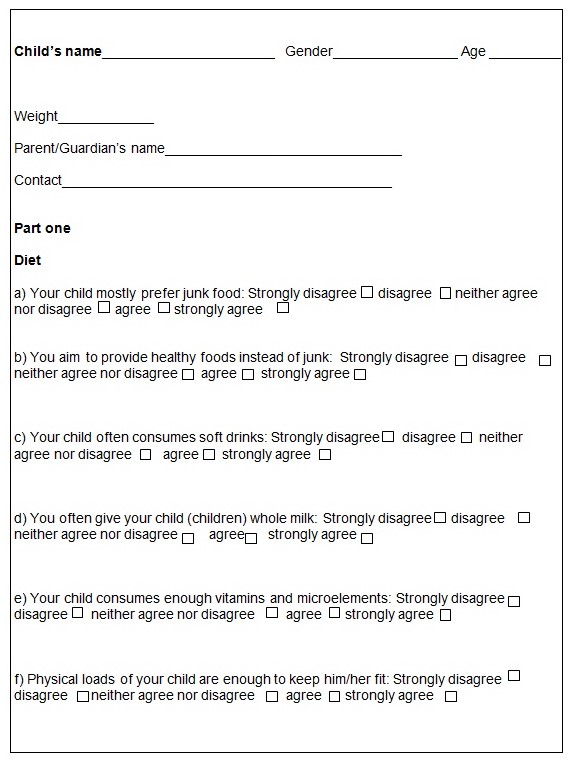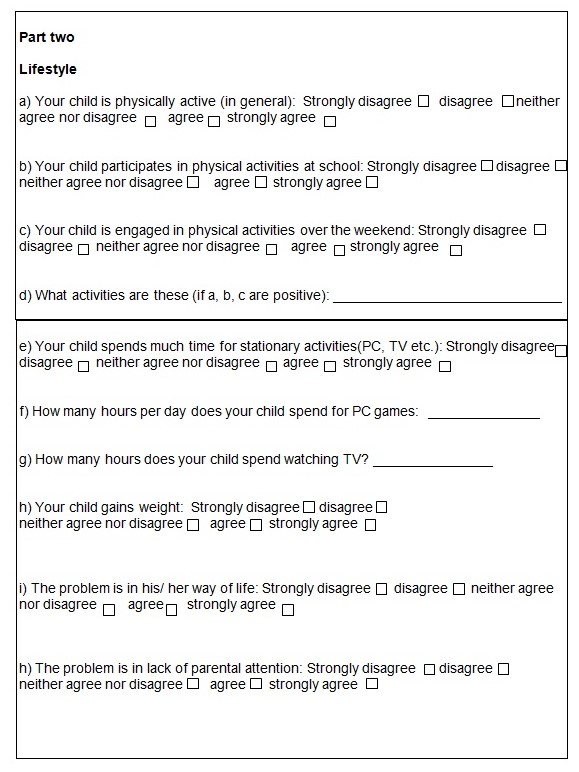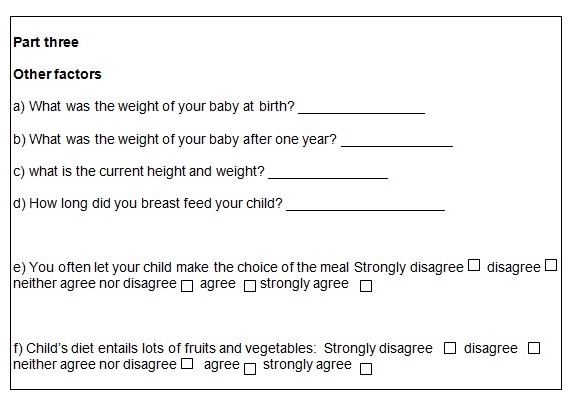Research question
Obesity in children and adolescents has increasingly become prevalent in the recent past and is now a major problem in most developed countries. In what ways can we determine the main causes of obesity in this age group and whom should the blame be placed on?
The Problem
According to government data, the number of overweight and obese children in Australia is continually rising. Society largely blames lack of parental guidance for this occurrence while parents blame advertising, food prices and a number of other factors. However, what do the children themselves think? Why do they think they are overweight? Do they hold anyone responsible for their weight issue? Do they see their weight as an issue at all? This study proposes to look at those questions in order to ascertain the attitudes and approaches of the children. Issues of power and agency are at the core of the issue of childhood obesity and as a society, we are led to believe that obesity should be treated as a sickness, a deviance. However, this functionalist perspective of health is not the most accurate and the concept of Health at Every Size refutes the very idea that particular weight denotes the individual as being unhealthy. The results of this study will provide important data for stakeholders in the anti-obesity crusade as well as those purporting HAES. Learning from the very subjects being discussed and decided for not only provides vital information for those making the decisions such as parents, government, medics, educators etc but also empowers those children who are classed as overweight, something other studies have shown is severely lacking for many such children.
Background
Obesity is regarded to be of epidemic proportions in Australia at this time. Studies have shown that there are more overweight and obese Australians than ever before. Government has instituted a number of preventative programs to combat rising rates of obesity but many believe this is not enough, that more needs to be done. It is the plight of overweight children that appears to cause the most concern for government, the medical profession and the community in general. Today’s children are believed to spend an excessive amount of time undertaking sedentary occupations such as TV viewing and computer usage. It is also believed that our children eat more junk food than the healthy, and often keep the non balanced diets.(Okie, 2005, p. 24).
Parents are held responsible for the eating habits of their children and in some countries authorities are moving towards recommending the removal of overweight children from their parents on the grounds of child abuse. Indeed, this has already taken place in some instances. Parents of overweight children deny neglect and state that there are more contributing factors that need to be taken into account: these are advertising, peer pressure, the rising cost of fresh food, access issues, poverty etc. This paper I claimed to review most of these factors, and conclude, what do the obese children really think of this problem, and who is responsible for children obesity.
Research methodology
This research will be held in a way to define the central causes of obesity in children as stated in the background information for this research. First, a research questionnaire will need to be designed and the target population for this research will be identified in order that the research can begin. (Okie, 2005, p. 24).
Target population
The target population for this research will be children, especially those aged from 12 years and below. This has to involve their parents and therefore has to be carried out in a way that the questions will be answered by their mothers or their guardians.
Willing parents can be interviewed face to face or can give out their contacts, especially their email addresses so that the questionnaires can be forwarded to them as most of the questions concern the habits of the child at home. As per the physical activities of the child at school, the parent can fill this part with assistance from the teacher. Research questionnaires can also be distributed in hospitals or clinics where these children are taken for medical check ups by their parents. Here the medical staff will help in filling up details concerning the health status of the child. These details could be weight, body mass index (BMI), as well as the levels of fat.
This research should reach out to as many people as possible in order to get a bigger number of participants and cater for an error margin, just in case some people do not return their questionnaires.
Research questionnaire
This questionnaire should seek to establish whether the child is obese and what kind of lifestyle the child is exposed to, before moving on to establish the cause of obesity in each case.
The respondent should choose one of the offered variants (Strongly disagree, disagree, neither agree nor disagree, agree, strongly agree)



Problems anticipated
One of the major problems that may be faced in this research is that some parents may not be willing to talk openly about their obese children and others may not necessarily give the right or the correct information concerning the questions in the questionnaire.
Again, some people may not be willing to spare some time and answer the questions and if the questionnaire ifs forwarded to them, they may not take their time and reply it, meaning that so, many questionnaires have to be distributed in order to cater for the margin of those who may not give a feedback. (Hills, 2007, p.33)
There is also a problem with the area that has to be covered for this research to be effective. It is of utmost importance that this research covers the whole country and therefore proper mechanism need to be set up so that all the corners of the country can be covered during the research period. This requires that representatives are sent to different towns and rural Australia in order to distribute the questionnaires.
Solving the problems
In order to overcome the problem of unwilling parents or guardians, it will be of most importance to explain to them the importance of the study to the health of their children.
Parents should be made to understand that this study will help establish the root cause of the problems of the child and that it is from here that the ways of solving the problem will be devised. With such clear explanation, most parents will most likely find it easy to talk about the condition of their children in an effort to seek help or an improvement in the health conditions of their children. As such, more people will be ready to listen to our representatives and will also take time and fill out our questionnaires (Hills, 2007, p.33).
Data analysis
Data will be classified in terms of age, weight of children, the type of food they eat as well as their life styles. Analysis will be done in a way that it will be possible to find out the average number of children with a certain age bracket who have obesity. This method of analysis will also put into consideration the cause of obesity in these children and at the end will also give the relevant and likely advice on what could be done to help reverse the health situation of the child or children in question.
The best form of analyzing this data will be through statistical means, in which a null and alternative hypothesis will be developed and tested. There are various statistical methods available for this method. First, the student’s t test can be used to test hypothesis on multiple measures on our population like for our case whether too much TV watching, a lot of sweetened and soft drinks and failure to take part in physical activities is a major cause of obesity in young children. This form of data analysis is referred to as multivariate testing would enable us to know for sure whether the various factors in question contribute to obesity in children. The t test can be applied to either one sample or two samples.
We can also use regression to establish whether there is any correlation between the kind of food that children eat and obesity, or the kind of lifestyle that a child live and obesity.(Tartamella, 2004, p. 47).
It is through these methods of data analysis that it will be possible to interpret the meaning of significance of the collected data and the scope of the research study.
Important measures
The weight of the child is important as it helps in determining whether the child is obese or not. The height is also important as it will help in calculating the body mass index of the child. (Kiess, 2004, p. 56).
Data tables
Tables will be grouped in terms of diet and life style as shown below:
Diet
Lifestyle
Data on these tables can be analyzed and grouped in terms of the ages and the average weight of children with obesity. It can also be analyzed based on the average amount of time children spend on watching TV or playing games. Another way of analysis would be looking at the results of the data per each region in Australia from which it would be possible to know which areas are adversely affected.
Conclusion
At the end of the study it should be possible to establish the possible causes of obesity in children and what can be done about it. As mentioned earlier, parents blame advertising to the bad habits of their children, so this study should help establish who should carry the blame.(Kiess, 2004, p. 56).
Potential Consequences of the Research
This research, although a necessary one in terms of information and sensitization, also come along with potential consequences. First, it is likely to cause stigmatization to children and adolescents who are obese. People may begin to see them differently and view them negatively. This is possible especially with young children in school. This could lead to uncomfortable lives for parents and children who have this disorder.
Enlightening people on the dangers of junk food could also result into low consumption, which in some cases may result in low sales from fast food outlets. This can the same case with sweet and carbonated drinks. The same case applies with computer games if many parents decide that their children should spend more time outside doing exercises. (Kiess, 2004, p. 56)
Appendix A
Parents generally report themselves, that their children are obese, and this reportings are presented on the graph. Nevertheless, some parents consider that their children of the normal weight, in spite of the obvious overweight, or probability of obesity. This data requires deep sociological research.
Most parents reveal their anxiety of the fact of their children obesity, but the average concern level is not enough for the successful struggle with obesity among children. These graphs and scales are important for the study of children obesity, as they provide the general image of the problem, and offer
Appendix B
Sports engagement
Children are active originally, but the contemporary electronic appliances and lack of physical activity among children lead to overweight. The percentage of overweight children is much less among those, who are engaged in outdoor games. Actually, the credibility of obesity remains, but the consequences would be less crucial, than for those, who lead stationary way of life.
Nutrition factors
This data table provides the information, that children who used to consume junk food (fast food, food with preservatives, soda with too much sugar and coloring agents) are more subjected to overweight and obesity. On the other hand, children who keep the diet full of necessary components less subjected to overweight, and these 4 percent have the problem of extremely different character (obesity is caused by hormonal violations).
Associated deceases
Obesity is often accompanied with, or reasoned by a particular decease. The most spread violations are connected with hormones (hypothesis injury), or diabetes.
References
Kiess, Wieland, (2004), Obesity in Childhood & Adolescents. Karger Publishers.
Tartamella, Lisa, (2004), Generation Extra Large: Rescuing our Children from The Epidemic of Obesity, Basic Books.
Okie, Susan,(2005), Fed Up, National Academic Press.
Hills, Andrew, (2007), Children, Obesity and Exercise, Routledge.